中考英语二轮复习课件 (共43张PPT) 副词相关知识点总结
文档属性
| 名称 | 中考英语二轮复习课件 (共43张PPT) 副词相关知识点总结 |  | |
| 格式 | zip | ||
| 文件大小 | 264.0KB | ||
| 资源类型 | 教案 | ||
| 版本资源 | 人教新目标(Go for it)版 | ||
| 科目 | 英语 | ||
| 更新时间 | 2022-09-16 13:27:12 | ||
图片预览

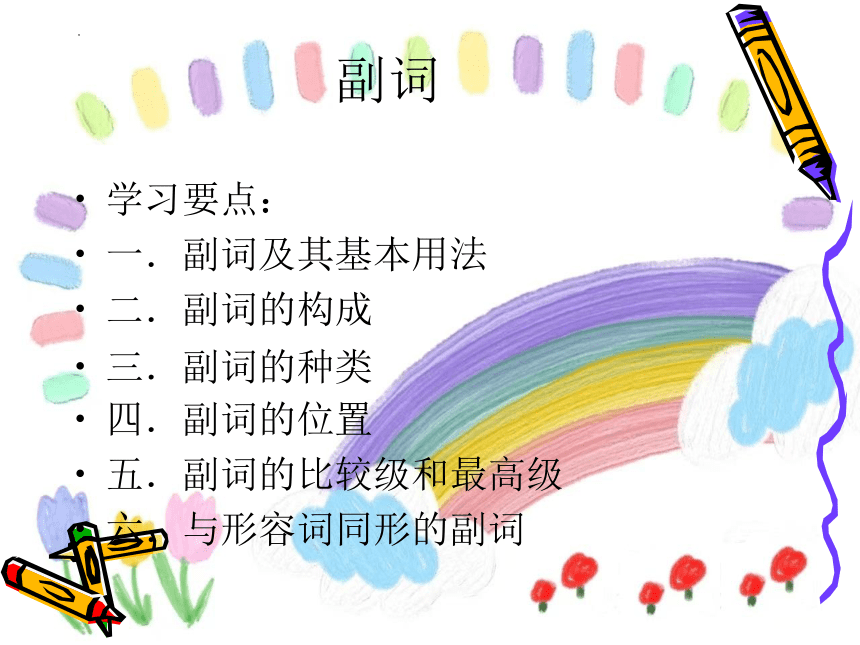
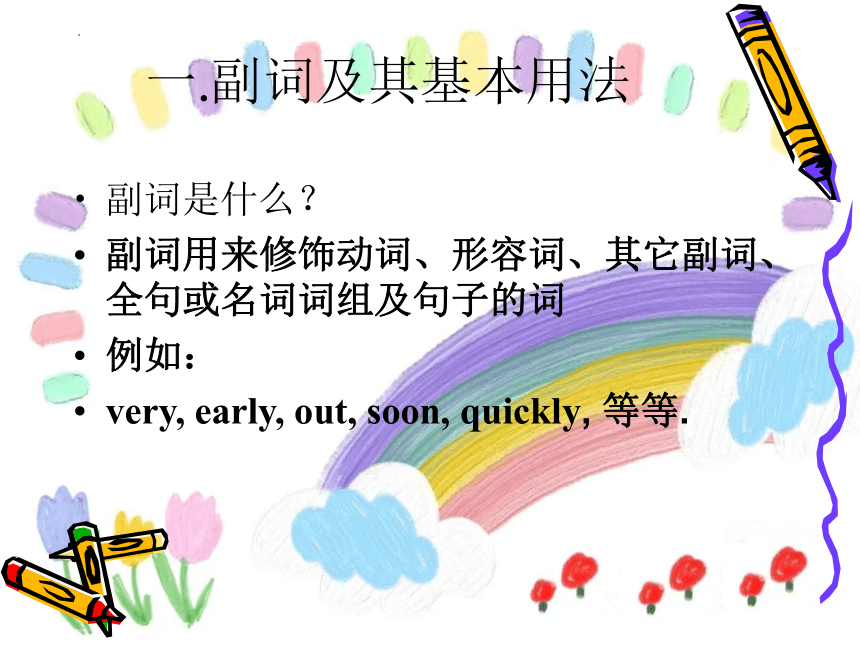

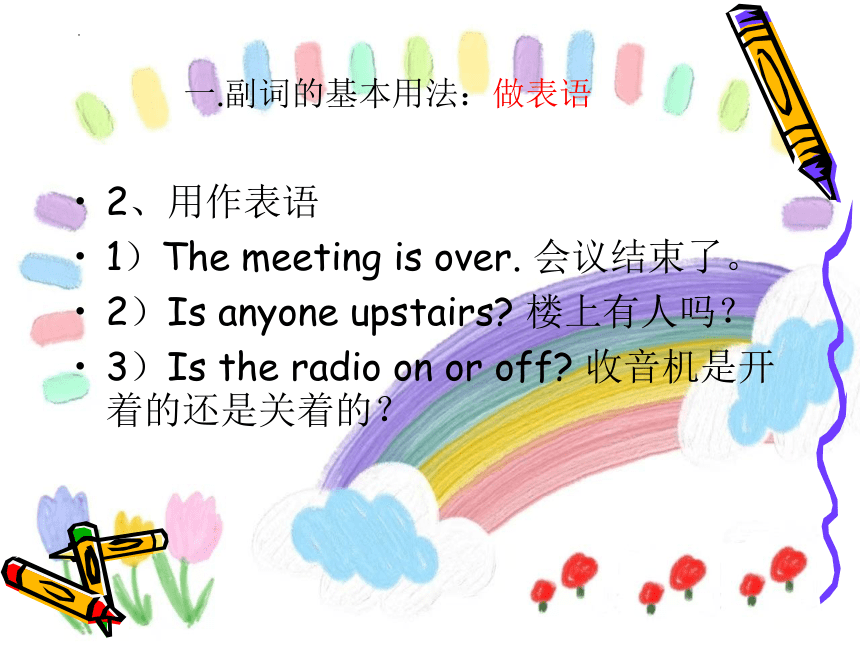
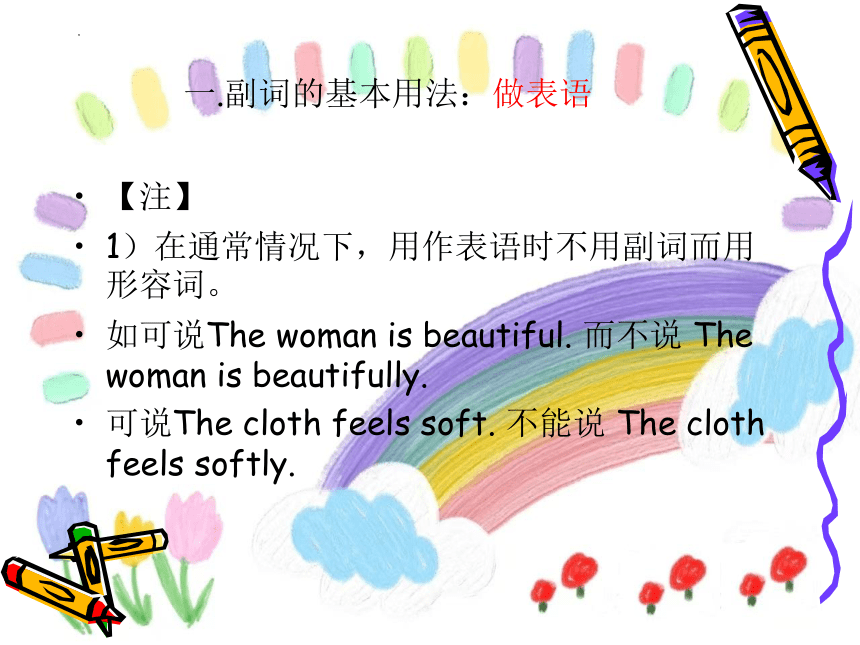
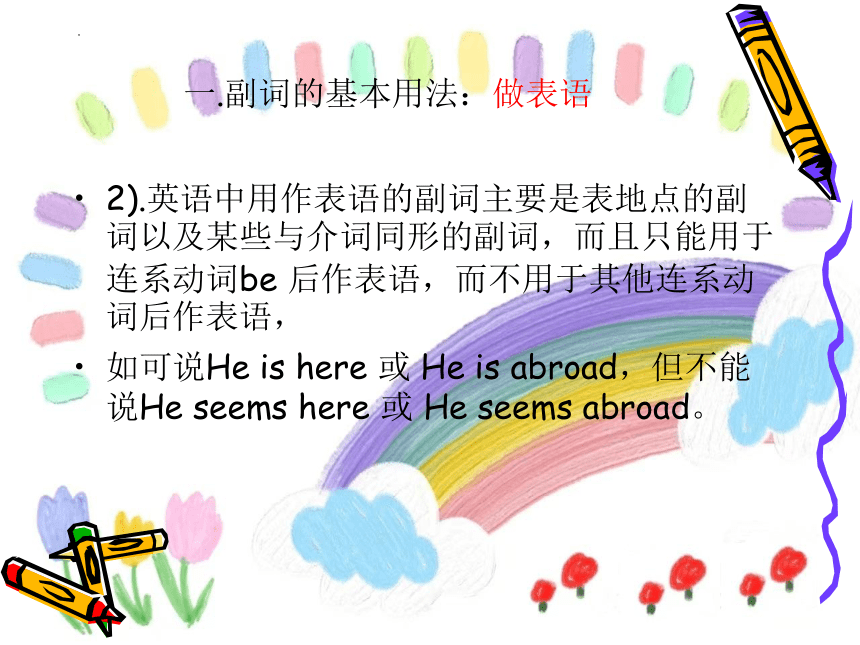

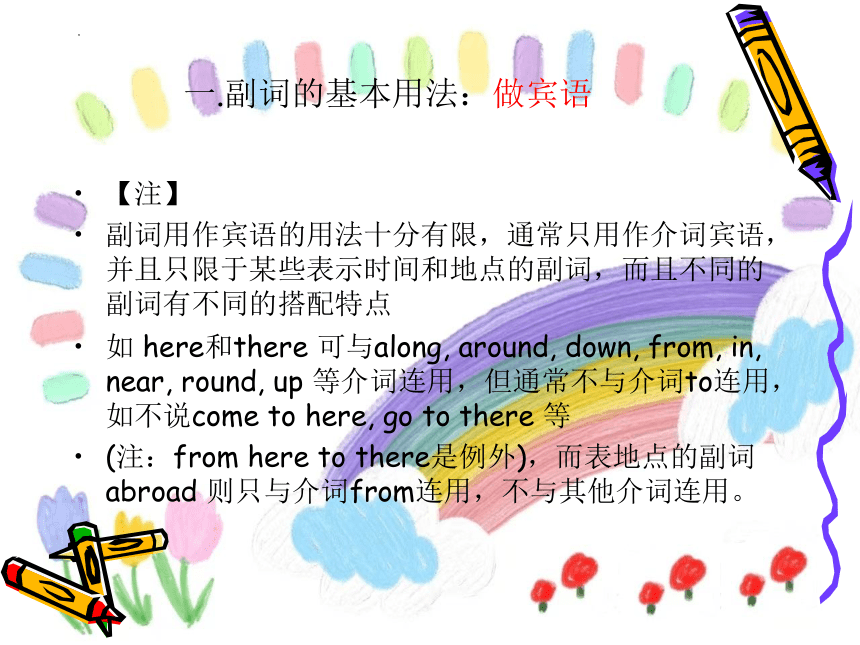
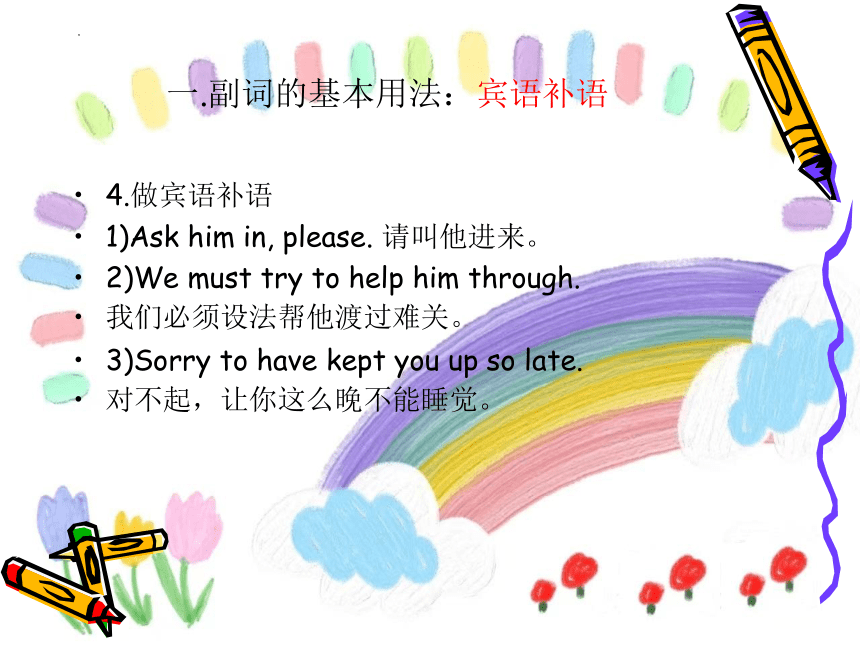
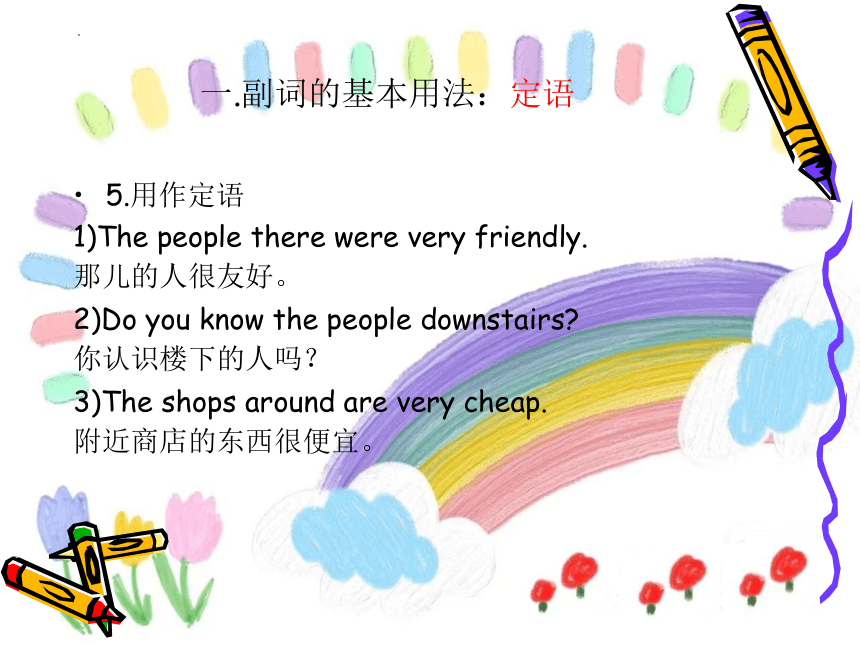
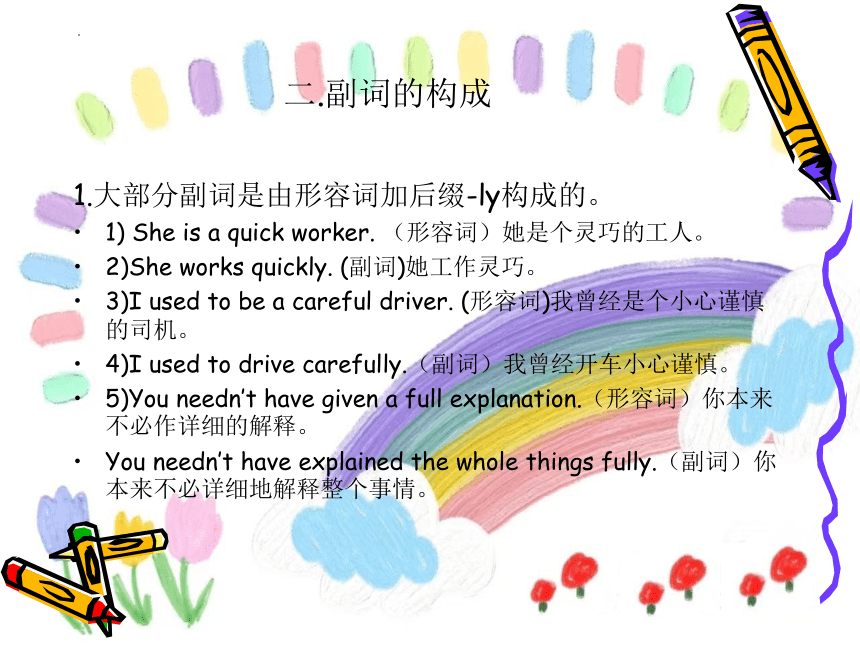
文档简介
(共43张PPT)
副词
副词
学习要点:
一.副词及其基本用法
二.副词的构成
三.副词的种类
四.副词的位置
五.副词的比较级和最高级
六.与形容词同形的副词
一.副词及其基本用法
副词是什么?
副词用来修饰动词、形容词、其它副词、全句或名词词组及句子的词
例如:
very, early, out, soon, quickly, 等等.
一.副词的基本用法:做状语
1、用作状语
1)Look at the photo carefully.
仔细看看这张照片。
2)You’re driving too fast.
你开车开得太快了。
2、用作表语
1)The meeting is over. 会议结束了。
2)Is anyone upstairs 楼上有人吗?
3)Is the radio on or off 收音机是开着的还是关着的?
一.副词的基本用法:做表语
【注】
1)在通常情况下,用作表语时不用副词而用形容词。
如可说The woman is beautiful. 而不说 The woman is beautifully.
可说The cloth feels soft. 不能说 The cloth feels softly.
一.副词的基本用法:做表语
2).英语中用作表语的副词主要是表地点的副词以及某些与介词同形的副词,而且只能用于连系动词be 后作表语,而不用于其他连系动词后作表语,
如可说He is here 或 He is abroad,但不能说He seems here 或 He seems abroad。
一.副词的基本用法:做表语
3.做宾语
1) It’s hot in here. 这里面很热。
2) It’s not far from here.
从这儿去不远。
3) I’ll stay at home tonight.
今晚我将呆在家里。
一.副词的基本用法:做宾语
【注】
副词用作宾语的用法十分有限,通常只用作介词宾语,并且只限于某些表示时间和地点的副词,而且不同的副词有不同的搭配特点
如 here和there 可与along, around, down, from, in, near, round, up 等介词连用,但通常不与介词to连用,如不说come to here, go to there 等
(注:from here to there是例外),而表地点的副词abroad 则只与介词from连用,不与其他介词连用。
一.副词的基本用法:做宾语
4.做宾语补语
1)Ask him in, please. 请叫他进来。
2)We must try to help him through.
我们必须设法帮他渡过难关。
3)Sorry to have kept you up so late.
对不起,让你这么晚不能睡觉。
一.副词的基本用法:宾语补语
5.用作定语
1)The people there were very friendly.
那儿的人很友好。
2)Do you know the people downstairs
你认识楼下的人吗?
3)The shops around are very cheap.
附近商店的东西很便宜。
一.副词的基本用法:定语
1.大部分副词是由形容词加后缀-ly构成的。
1) She is a quick worker. (形容词)她是个灵巧的工人。
2)She works quickly. (副词)她工作灵巧。
3)I used to be a careful driver. (形容词)我曾经是个小心谨慎的司机。
4)I used to drive carefully.(副词)我曾经开车小心谨慎。
5)You needn’t have given a full explanation.(形容词)你本来不必作详细的解释。
You needn’t have explained the whole things fully.(副词)你本来不必详细地解释整个事情。
二.副词的构成
【注意】
有一部分以ly结尾的形容词,而不是副词。
例如:lively, motherly, fatherly, silly, womanly等。但是用它们可以构成短语。
例如:
Although she is our teacher, she always treats us all in a motherly manner.
虽然她是我们的老师,但是她总是慈母般地对待我们大家。
二.副词的构成
2.在某些介词或地点名词加后缀-wards构成,表示“向……”。
例如 :
backward(s) 向后 forward(s) 向前,前进
upward(s) 向上 downward(s) 向下
southward(s) 向南 northward(s) 向北
inward 向内,向中心 outward 向外
二.副词的构成
1、方式副词(Adverbs of Manner):表示“怎样做”的副词叫作方式副词。
例如:
1)Let’s go to the cinema together.
让我们一起去看电影。
2)We will finish this task easily.
我们将很容易地完成此任务。
3)My little brother behaved badly.
我的小弟弟行为不好。
三.副词种类
常用的方式副词有:
anyhow 无论如何 actively 积极地
slowly 慢地 gravely 严重地 immediately 立刻,
马上 finally 最后地 boldly 勇敢地 calmly 冷静地
late 迟 early 早 carefully 小心地
distinctly 清楚地 quickly 迅速地 quietly 安静地
三.副词种类
2、 地点副词(Adverbs of Place):说明动作在什么地方发生的副词。
1)Please stand there. 请你站那边。
2)We have looked everywhere for our missing schoolbags.我们到处都找过我们的书包了。
3)What has happened to him He has been pacing to and fro for about three hours. .
他怎么了?他踱来踱去已经有大约三个小时了。
4)Yesterday I went nowhere. 昨天我什么地方也没有去。
三.副词种类
常用的地点副词有:
across 越过 above 在……上面
here 这里 there 那里
abroad 海外,国外 inland 到( 在)内地
anywhere无论那里 nowhere 那里也不
elsewhere 往别处 somewhere 某地
below 在…下方 everywhere 处处
upstairs 在楼上 downstairs 在楼下
along 沿着
三.副词种类
3、时间副词(Adverbs of Time):表示动作是什么时候发生的副词。
1)She got up so early that she could catch the first bus. 为了赶上头班车她起得很早。
2)What we are going to do next hasn’t been decided. 我们下一步做什么还没有决定。
3)He hasn’t come yet. 他还没有来。
4)I have read ten books recently. 最近我看了十本书。
三.副词种类
常见的时间副词有:
ago 以前 after 以后 today 今天
yesterday 昨天 tomorrow 明天 tonight 今夜
nowadays 现今 lately 最近 recently 最近
soon 不久以后 immediately 立刻 presently 目前 shortly 立刻 afterward以后 already 已经
三.副词种类
注:
在时间副词中还包含频度副词:表示不定时间的副词叫频度副词。
对频度副词提问用“How often”。频度副词应放在行为动词之前或者连系动词之后。
例如:
1)She sometimes comes to school late. 有时她上学迟到。
2)Never have I seen this film. 我从来没有看过这部电影。
三.副词种类
常见的频度副词有:
often 常常 always 永远,总是
sometimes 有时 usually 平常
seldom 很少 never 从不
ever 在任何时候 rarely 难得,很少
continually 不断地 frequently 经常地
三.副词种类
4、程度副词(Adverbs of Degree):程度副词一般用来修饰形容词或者副词。但有的也可以修饰动词。
例如:
1) I am quite sure that you are right.
我很有把握你是对的。
2)This novel is well worth reading.
这本小说很值得一看。
3)My reply pleased our headmaster very much.
我的答复使我们的校长很满意。
三.副词种类
常用的程度副词有:
as 同样,一样 altogether 完全,总共
almost 几乎,差不多 all 完全
absolutely 绝对地 completely 完全地
deeply 深深地 distinctly 显然地
enormously 巨大地 entirely 完全地
三.副词种类
5、关系副词(Relative Adverbs):用来引导定语从句,在从句中作状语。
例如:
1)This is the place where I used to live. 这就是我曾经住过的地方。
2)I don’t know the time when they left for Canada.我不知道他们什么时间去加拿大的。
3)If you tell me where you come from, I will give you some useful information.
如果你告诉我你从哪儿来,我将给你提供一些有用的消息。
三.副词种类
6、疑问副词(Interrogative Adverbs):用来提出问题的副词。
例如:
1)Where did you put my book 你把我的书放在哪儿了?
2)How did you go there 你是怎样去那儿的?
3)Why did you not come to school 你为什么没有来上学?
三.副词种类
常用的肯定和否定副词有:
No 不是的
Not 不 never 从不
certainly 当然,一定 surely 一定
naturally 自然 obviously 明显
willingly 乐意地 surely 肯定
decidedly 坚决地 indeed 确实
evidently 明显地 absolutely 绝对
三.副词种类
7、句子副词:修饰整个句子,表示说话人的看法。
例如:
1)Luckily,she was at home when I called on her.
2)Surprisingly, she was married to her classmate.
三.副词种类
1. 多数副词放在be动词、助动词或情态动词之后,实义动词之前。 如果实义动词后有宾语,则放于宾语之后。
例句:
1) I am also Bush.
2) I can also do that.
3) I also want to play that game.
4) I get up early in the morning every day.
四.副词的位置
2. 副词修饰形容词时,一般放在被修饰词之前,但enough除外。
例句:
1) He did it quite well.
2) It's rather difficult to tell who is right.
3) He didn't run fast enough to catch the train.
四.副词的位置
3. 频度副词可放在实义动词的前面,情态动词和助动词的后面。
例句:
1) I often help him these days.
2) I always remember the day when I first came to this school.
3) You couldn't always help me.
四.副词的位置
4. 疑问副词,连接副词,关系副词以及修饰整个句子的副词,通常放在句子或从句的前面。
例句:
1) When do you study everyday
2.) Can you tell me how you did it
3.) The students were reading when the teacher came into the classroom.
四.副词的位置
5. 时间副词和地点副词在一个句中, 地点副词在前面,时间副词在后面。
例句:
1) We went shopping in the supermarket at 9 o'clock yesterday.
2) What were you doing in the classroom yesterday afternoon
3) The accident took place in the Eleven Avenue one hour ago.
四.副词的位置
6.否定副词在句首,句子要部分倒装。
例句:
Never have I felt so excited!
我从来没有觉得这么激动!
四.副词的位置
1.规则变化
单音节词的比较级和最高级在词尾加-er或-est;
多音节词以及-ly结尾的副词(early除外),前面须加more 或most.
五.副词的比较级和最高级
1.规则变化
五.副词的比较级和最高级
原级 比较级 最高级
soon sooner soonest
long longer longest
early earlier earliest
happily more happily most happily
carefully more carefully most carefully
2.不规则变化
五.副词的比较级和最高级
原级 比较级 最高级
well better best
badly worse worst
little less least
much more most
far farther/further farthest/further
3.副词的比较级的用法
1)单独使用
例句:
①Try to do better next time. 下次争取干好一点。
②I had seen the film only a few days earlier.
是几天前才看的这部电影。
③He’ll come back sooner or later. 他迟早会回来的。
五.副词的比较级和最高级
3.副词的比较级的用法
2)和than一起使用:
例句:
①He swims better than I do. 他游泳游得比我好。
②He works less than he used to.
他工作的时间比以前少了。
③Can you do any better than that 你能不能干的好一些?
五.副词的比较级和最高级
注意:
形容词的最高级前要用定冠词the,
副词的最高级前可用可不用定冠词the.
Mount Qomolangma is the highest in the world.
Jim jumped (the) highest of the all.
五.副词的比较级和最高级
一,将以下形容词变为副词。
例:quiet ---- quietly
1. hopeful ---- 2. careless ----
3. healthy ---- 4. busy ----
5. fortunate ---- 6. suitable ----
7. fast ---- 8. active ----
六. 副词练习
二,用恰当的词填空。
1.It rains (heavy) today than yesterday.
2.A young girl is crying (bitter) there.
3.Jane jumped (high) than other girls.
4.He plays the piano (well) in his class.
5.We can’t hear you. You have to speak (loud).
6.Which season do you like (good).
六. 副词练习
三,依据所给的中文提示完成句子。
1. 他于2022年4月21日生于北京。
He was born .
2. 我们明天早上八点在学校门口见。
We’ll meet .
3. 学生们昨天下午四点半成功地完成了工作。
The students finished the work .
六. 副词练习
副词
副词
学习要点:
一.副词及其基本用法
二.副词的构成
三.副词的种类
四.副词的位置
五.副词的比较级和最高级
六.与形容词同形的副词
一.副词及其基本用法
副词是什么?
副词用来修饰动词、形容词、其它副词、全句或名词词组及句子的词
例如:
very, early, out, soon, quickly, 等等.
一.副词的基本用法:做状语
1、用作状语
1)Look at the photo carefully.
仔细看看这张照片。
2)You’re driving too fast.
你开车开得太快了。
2、用作表语
1)The meeting is over. 会议结束了。
2)Is anyone upstairs 楼上有人吗?
3)Is the radio on or off 收音机是开着的还是关着的?
一.副词的基本用法:做表语
【注】
1)在通常情况下,用作表语时不用副词而用形容词。
如可说The woman is beautiful. 而不说 The woman is beautifully.
可说The cloth feels soft. 不能说 The cloth feels softly.
一.副词的基本用法:做表语
2).英语中用作表语的副词主要是表地点的副词以及某些与介词同形的副词,而且只能用于连系动词be 后作表语,而不用于其他连系动词后作表语,
如可说He is here 或 He is abroad,但不能说He seems here 或 He seems abroad。
一.副词的基本用法:做表语
3.做宾语
1) It’s hot in here. 这里面很热。
2) It’s not far from here.
从这儿去不远。
3) I’ll stay at home tonight.
今晚我将呆在家里。
一.副词的基本用法:做宾语
【注】
副词用作宾语的用法十分有限,通常只用作介词宾语,并且只限于某些表示时间和地点的副词,而且不同的副词有不同的搭配特点
如 here和there 可与along, around, down, from, in, near, round, up 等介词连用,但通常不与介词to连用,如不说come to here, go to there 等
(注:from here to there是例外),而表地点的副词abroad 则只与介词from连用,不与其他介词连用。
一.副词的基本用法:做宾语
4.做宾语补语
1)Ask him in, please. 请叫他进来。
2)We must try to help him through.
我们必须设法帮他渡过难关。
3)Sorry to have kept you up so late.
对不起,让你这么晚不能睡觉。
一.副词的基本用法:宾语补语
5.用作定语
1)The people there were very friendly.
那儿的人很友好。
2)Do you know the people downstairs
你认识楼下的人吗?
3)The shops around are very cheap.
附近商店的东西很便宜。
一.副词的基本用法:定语
1.大部分副词是由形容词加后缀-ly构成的。
1) She is a quick worker. (形容词)她是个灵巧的工人。
2)She works quickly. (副词)她工作灵巧。
3)I used to be a careful driver. (形容词)我曾经是个小心谨慎的司机。
4)I used to drive carefully.(副词)我曾经开车小心谨慎。
5)You needn’t have given a full explanation.(形容词)你本来不必作详细的解释。
You needn’t have explained the whole things fully.(副词)你本来不必详细地解释整个事情。
二.副词的构成
【注意】
有一部分以ly结尾的形容词,而不是副词。
例如:lively, motherly, fatherly, silly, womanly等。但是用它们可以构成短语。
例如:
Although she is our teacher, she always treats us all in a motherly manner.
虽然她是我们的老师,但是她总是慈母般地对待我们大家。
二.副词的构成
2.在某些介词或地点名词加后缀-wards构成,表示“向……”。
例如 :
backward(s) 向后 forward(s) 向前,前进
upward(s) 向上 downward(s) 向下
southward(s) 向南 northward(s) 向北
inward 向内,向中心 outward 向外
二.副词的构成
1、方式副词(Adverbs of Manner):表示“怎样做”的副词叫作方式副词。
例如:
1)Let’s go to the cinema together.
让我们一起去看电影。
2)We will finish this task easily.
我们将很容易地完成此任务。
3)My little brother behaved badly.
我的小弟弟行为不好。
三.副词种类
常用的方式副词有:
anyhow 无论如何 actively 积极地
slowly 慢地 gravely 严重地 immediately 立刻,
马上 finally 最后地 boldly 勇敢地 calmly 冷静地
late 迟 early 早 carefully 小心地
distinctly 清楚地 quickly 迅速地 quietly 安静地
三.副词种类
2、 地点副词(Adverbs of Place):说明动作在什么地方发生的副词。
1)Please stand there. 请你站那边。
2)We have looked everywhere for our missing schoolbags.我们到处都找过我们的书包了。
3)What has happened to him He has been pacing to and fro for about three hours. .
他怎么了?他踱来踱去已经有大约三个小时了。
4)Yesterday I went nowhere. 昨天我什么地方也没有去。
三.副词种类
常用的地点副词有:
across 越过 above 在……上面
here 这里 there 那里
abroad 海外,国外 inland 到( 在)内地
anywhere无论那里 nowhere 那里也不
elsewhere 往别处 somewhere 某地
below 在…下方 everywhere 处处
upstairs 在楼上 downstairs 在楼下
along 沿着
三.副词种类
3、时间副词(Adverbs of Time):表示动作是什么时候发生的副词。
1)She got up so early that she could catch the first bus. 为了赶上头班车她起得很早。
2)What we are going to do next hasn’t been decided. 我们下一步做什么还没有决定。
3)He hasn’t come yet. 他还没有来。
4)I have read ten books recently. 最近我看了十本书。
三.副词种类
常见的时间副词有:
ago 以前 after 以后 today 今天
yesterday 昨天 tomorrow 明天 tonight 今夜
nowadays 现今 lately 最近 recently 最近
soon 不久以后 immediately 立刻 presently 目前 shortly 立刻 afterward以后 already 已经
三.副词种类
注:
在时间副词中还包含频度副词:表示不定时间的副词叫频度副词。
对频度副词提问用“How often”。频度副词应放在行为动词之前或者连系动词之后。
例如:
1)She sometimes comes to school late. 有时她上学迟到。
2)Never have I seen this film. 我从来没有看过这部电影。
三.副词种类
常见的频度副词有:
often 常常 always 永远,总是
sometimes 有时 usually 平常
seldom 很少 never 从不
ever 在任何时候 rarely 难得,很少
continually 不断地 frequently 经常地
三.副词种类
4、程度副词(Adverbs of Degree):程度副词一般用来修饰形容词或者副词。但有的也可以修饰动词。
例如:
1) I am quite sure that you are right.
我很有把握你是对的。
2)This novel is well worth reading.
这本小说很值得一看。
3)My reply pleased our headmaster very much.
我的答复使我们的校长很满意。
三.副词种类
常用的程度副词有:
as 同样,一样 altogether 完全,总共
almost 几乎,差不多 all 完全
absolutely 绝对地 completely 完全地
deeply 深深地 distinctly 显然地
enormously 巨大地 entirely 完全地
三.副词种类
5、关系副词(Relative Adverbs):用来引导定语从句,在从句中作状语。
例如:
1)This is the place where I used to live. 这就是我曾经住过的地方。
2)I don’t know the time when they left for Canada.我不知道他们什么时间去加拿大的。
3)If you tell me where you come from, I will give you some useful information.
如果你告诉我你从哪儿来,我将给你提供一些有用的消息。
三.副词种类
6、疑问副词(Interrogative Adverbs):用来提出问题的副词。
例如:
1)Where did you put my book 你把我的书放在哪儿了?
2)How did you go there 你是怎样去那儿的?
3)Why did you not come to school 你为什么没有来上学?
三.副词种类
常用的肯定和否定副词有:
No 不是的
Not 不 never 从不
certainly 当然,一定 surely 一定
naturally 自然 obviously 明显
willingly 乐意地 surely 肯定
decidedly 坚决地 indeed 确实
evidently 明显地 absolutely 绝对
三.副词种类
7、句子副词:修饰整个句子,表示说话人的看法。
例如:
1)Luckily,she was at home when I called on her.
2)Surprisingly, she was married to her classmate.
三.副词种类
1. 多数副词放在be动词、助动词或情态动词之后,实义动词之前。 如果实义动词后有宾语,则放于宾语之后。
例句:
1) I am also Bush.
2) I can also do that.
3) I also want to play that game.
4) I get up early in the morning every day.
四.副词的位置
2. 副词修饰形容词时,一般放在被修饰词之前,但enough除外。
例句:
1) He did it quite well.
2) It's rather difficult to tell who is right.
3) He didn't run fast enough to catch the train.
四.副词的位置
3. 频度副词可放在实义动词的前面,情态动词和助动词的后面。
例句:
1) I often help him these days.
2) I always remember the day when I first came to this school.
3) You couldn't always help me.
四.副词的位置
4. 疑问副词,连接副词,关系副词以及修饰整个句子的副词,通常放在句子或从句的前面。
例句:
1) When do you study everyday
2.) Can you tell me how you did it
3.) The students were reading when the teacher came into the classroom.
四.副词的位置
5. 时间副词和地点副词在一个句中, 地点副词在前面,时间副词在后面。
例句:
1) We went shopping in the supermarket at 9 o'clock yesterday.
2) What were you doing in the classroom yesterday afternoon
3) The accident took place in the Eleven Avenue one hour ago.
四.副词的位置
6.否定副词在句首,句子要部分倒装。
例句:
Never have I felt so excited!
我从来没有觉得这么激动!
四.副词的位置
1.规则变化
单音节词的比较级和最高级在词尾加-er或-est;
多音节词以及-ly结尾的副词(early除外),前面须加more 或most.
五.副词的比较级和最高级
1.规则变化
五.副词的比较级和最高级
原级 比较级 最高级
soon sooner soonest
long longer longest
early earlier earliest
happily more happily most happily
carefully more carefully most carefully
2.不规则变化
五.副词的比较级和最高级
原级 比较级 最高级
well better best
badly worse worst
little less least
much more most
far farther/further farthest/further
3.副词的比较级的用法
1)单独使用
例句:
①Try to do better next time. 下次争取干好一点。
②I had seen the film only a few days earlier.
是几天前才看的这部电影。
③He’ll come back sooner or later. 他迟早会回来的。
五.副词的比较级和最高级
3.副词的比较级的用法
2)和than一起使用:
例句:
①He swims better than I do. 他游泳游得比我好。
②He works less than he used to.
他工作的时间比以前少了。
③Can you do any better than that 你能不能干的好一些?
五.副词的比较级和最高级
注意:
形容词的最高级前要用定冠词the,
副词的最高级前可用可不用定冠词the.
Mount Qomolangma is the highest in the world.
Jim jumped (the) highest of the all.
五.副词的比较级和最高级
一,将以下形容词变为副词。
例:quiet ---- quietly
1. hopeful ---- 2. careless ----
3. healthy ---- 4. busy ----
5. fortunate ---- 6. suitable ----
7. fast ---- 8. active ----
六. 副词练习
二,用恰当的词填空。
1.It rains (heavy) today than yesterday.
2.A young girl is crying (bitter) there.
3.Jane jumped (high) than other girls.
4.He plays the piano (well) in his class.
5.We can’t hear you. You have to speak (loud).
6.Which season do you like (good).
六. 副词练习
三,依据所给的中文提示完成句子。
1. 他于2022年4月21日生于北京。
He was born .
2. 我们明天早上八点在学校门口见。
We’ll meet .
3. 学生们昨天下午四点半成功地完成了工作。
The students finished the work .
六. 副词练习
同课章节目录
- 词法
- 名词
- 动词和动词短语
- 动词语态
- 动词时态
- 助动词和情态动词
- 非谓语动词
- 冠词
- 代词
- 数词和量词
- 形容词副词及其比较等级
- 介词和介词短语
- 连词和感叹词
- 构词法
- 相似、相近词比较
- 句法
- 陈述句
- 一般疑问句和否定疑问句
- 特殊疑问句及选择疑问句
- 反意疑问句
- 存在句(There be句型)
- 宾语从句
- 定语从句
- 状语从句
- 主谓一致问题
- 简单句
- 并列句
- 复合句
- 主谓一致
- 主、表语从句
- 名词性从句
- 直接引语和间接引语
- 虚拟语气
- 感叹句
- 强调句
- 倒装句
- 祈使句
- 句子的成分
- 句子的分类
- 题型专区
- 单项选择部分
- 易错题
- 完形填空
- 阅读理解
- 词汇练习
- 听说训练
- 句型转换
- 补全对话
- 短文改错
- 翻译
- 书面表达
- 任务型阅读
- 语法填空
- 其他资料
